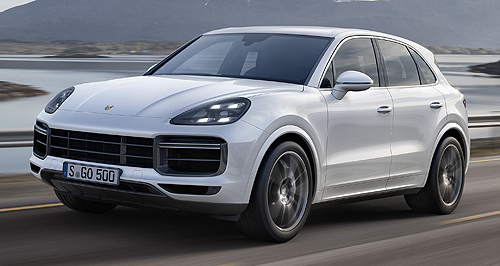Make / Model Search
Future models - Porsche - Cayenne - TurboFrankfurt show: Porsche ups Cayenne ante with TurboGreat eight: The new Porsche Cayenne Turbo gets the same 4.0-litre twin-turbo V8 as the latest Panamera. Porsche’s new-gen Cayenne Turbo gets 404kW twin-turbo V8 and trick chassisGallery Click to see larger images 13 Sep 2017 ANOTHER chapter of the third-generation Porsche Cayenne story was written at the Frankfurt motor show overnight with the unveiling of an all-new Cayenne Turbo powered by a smaller but more powerful twin-turbo V8. The Cayenne Turbo becomes the third variant of Porsche’s flagship large SUV range to be detailed, following in the tread marks of the base Cayenne and Cayenne S – each powered by V6 petrol-turbo engines – that were revealed in the lead up to the big German auto expo. If Porsche is playing to the same song book as the previous generation Cayenne, that leaves diesel, hybrid and – at the very top of the power tree – Cayenne Turbo S to come in the new-generation vehicle that sits on an all-new lightweight platform shared with other high-end Volkswagen Group large SUVs such as the Audi Q7 and Bentley Bentayga. Porsche Cars Australia has confirmed the Cayenne Turbo for Australia, saying it is expected to debut alongside the V6 variants in mid-2018. Pricing and Australian specifications for all three initial variants will be announced in early 2018. At the heart of the Cayenne Turbo is the Porsche-designed 4.0-litre twin-turbo V8 that turns out 404kW of power and 770Nm or torque – 22kW and 20Nm more than the current 4.8-litre unit in the outgoing Cayenne Turbo. While the powertrain is identical to that of the latest Panamera Turbo – including a Tiptronic eight-speed automatic transmission – the bigger, bulkier Cayenne is a little slower in the 0-100km/h sprint, hitting the mark in 4.1 seconds compared with the Panamera’s 3.6s. However, the addition of the extra-cost Sports Chrono package cuts the Cayenne’s dash time to 3.9s. The Cayenne Turbo’s top speed is 286km/h. To help slow the big beast from autobahn speeds, the Cayenne gets an adaptive rear spoiler that tilts upwards to create an aero brake. Porsche says the device cuts two metres from the stopping distance from 250km/h. Although the V8 is 800cc smaller than before, it appears to be slightly thirstier. The European combined test cycle fuel figure quoted in the press release is 11.9 litres per 100km, which is 0.4L/100km higher than the current vehicle’s 11.5L/100km. The Turbo gets high-performance brakes coated with a layer of tungsten carbide. If the owner wants to go the whole hog, ceramic composite brakes are optional. Setting the Turbo apart from lesser variants are double-row LED headlights and hefty 21-inch alloy wheels that – like those on other Cayennes in the new generation – are fatter at the back (315/35) than the front (285/40). To accommodate the big wheels, the wheel arches have been widened. At the back, quad exhaust pipes with a design exclusive to the Turbo protrude from a black-finished rear diffuser that sits beneath a body-colour rear apron. The Turbo sits on active air suspension with three-chambers. The system provides five driving modes and six selectable height levels, including one for off-road travel. A 48-volt electric-controlled Porsche Dynamic Chassis Control (PDCC) roll stabilisation system works in tandem with the all-wheel-drive torque vectoring and rear-wheel steering for what Porsche describes as the driving dynamics of a sports car and everyday comfort and easy parking and turning manoeuvres. Inside, top-of-the-range sports seats and a 710-watt Bose sound systems are among the highlights, on top of other new design features outlined for the new Cayenne, including a new, bigger infotainment system with more connectivity. The front seats have 18-way electric adjustment have integrated headrests and heating, and are finished in what Porsche describes as an exclusive Turbo design.  Read more30th of August 2017  Frankfurt show: ‘More Porsche’ Cayenne revealedLighter, faster Porsche Cayenne shown off ahead of its Frankfurt show debutAll motor show Alfa Romeo Alfa Romeo Abarth Abarth Alpine Alpine Alpina Alpina Audi Audi Aston Martin Aston Martin BMW BMW Bentley Bentley Chery Chery Brabham Brabham Chrysler Chrysler Chevrolet Chevrolet Cupra Cupra Citroen Citroen DS DS Dodge Dodge Fiat Fiat Ferrari Ferrari Foton Foton Ford Ford Great Wall Great Wall FPV FPV Haval Haval GWM GWM Honda Honda Holden Holden Hummer Hummer HSV HSV Infiniti Infiniti Hyundai Hyundai Jaguar Jaguar Isuzu Isuzu Kia Kia Jeep Jeep Land Rover Land Rover Lamborghini Lamborghini Lexus Lexus LDV LDV Mahindra Mahindra Lotus Lotus Mazda Mazda Maserati Maserati Mercedes-AMG Mercedes-AMG McLaren McLaren MG MG Mercedes-Benz Mercedes-Benz Mitsubishi Mitsubishi Mini Mini Opel Opel Nissan Nissan Peugeot Peugeot Pagani Pagani Proton Proton Porsche Porsche Renault Renault Ram Ram Rover Rover Rolls-Royce Rolls-Royce Skoda Skoda Saab Saab SsangYong SsangYong Smart Smart Suzuki Suzuki Subaru Subaru Toyota Toyota Tesla Tesla Volvo VolvoMotor industry news |
Click to shareAll motor show Alfa Romeo Alfa Romeo Abarth Abarth Alpine Alpine Alpina Alpina Audi Audi Aston Martin Aston Martin BMW BMW Bentley Bentley Chery Chery Brabham Brabham Chrysler Chrysler Chevrolet Chevrolet Cupra Cupra Citroen Citroen DS DS Dodge Dodge Fiat Fiat Ferrari Ferrari Foton Foton Ford Ford Great Wall Great Wall FPV FPV Haval Haval GWM GWM Honda Honda Holden Holden Hummer Hummer HSV HSV Infiniti Infiniti Hyundai Hyundai Jaguar Jaguar Isuzu Isuzu Kia Kia Jeep Jeep Land Rover Land Rover Lamborghini Lamborghini Lexus Lexus LDV LDV Mahindra Mahindra Lotus Lotus Mazda Mazda Maserati Maserati Mercedes-AMG Mercedes-AMG McLaren McLaren MG MG Mercedes-Benz Mercedes-Benz Mitsubishi Mitsubishi Mini Mini Opel Opel Nissan Nissan Peugeot Peugeot Pagani Pagani Proton Proton Porsche Porsche Renault Renault Ram Ram Rover Rover Rolls-Royce Rolls-Royce Skoda Skoda Saab Saab SsangYong SsangYong Smart Smart Suzuki Suzuki Subaru Subaru Toyota Toyota Tesla Tesla Volvo VolvoMotor industry news |





















Facebook Twitter Instagram